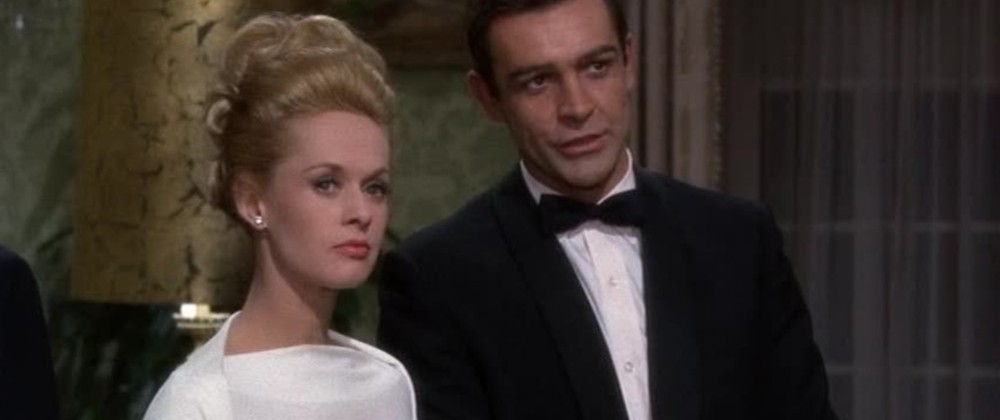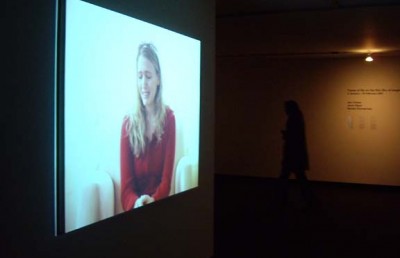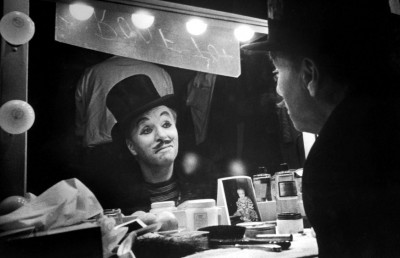Suicide Doors: Bi-sexing Modleski, Marnie, and the Lincoln Continental
Theoretical Fun

Critical inquiries are not settled by consulting the oracle.
W.K. Wimsatt, Jr. & M.C. Beardsley, 1954. [1]
In her seminal post-feminist reading of the works of Alfred Hitchcock, The Women Who Knew Too Much, Tania Modleski asserts an integral binarism: “[the] male spectator is as much ‘deconstructed’ as constructed by the films, which reveals a fascination with femininity that throws masculine identity into question and crisis.”2 Indeed, this ‘crisis of masculinity’ is a –if not the– central trope of much auterist criticism of the filmmaker’s text since the inception of both Hitchcock and the auterist prototype. However, this particular analysis is, ab initio, no more an attempt –as previous theorists (i.e. Bellour) have made– to rehabilitate the patriarchal ideal of Hitchcock-as-auteur for discursive feminist criticism, as it is an incantation and flourish of said criticism to support (if not further) Modleski’s thesis that: “[…] the strong fascination and identification with femininity revealed in [Hitchcock films] subverts the claims to mastery and authority not only of the male characters but of the director himself.” [3] Addenda can be applied in the form of potentially connective notions: both of implicit authorial intentionality, as well as interstitial, ‘free-floating,’ or (un)differentiated spectatorial position. And though Modleski largely ignores the film (focusing instead upon ?Vertigo??, 1958), it is in this way that, particularly, Marnie (1964) is an apt subject to bisexual critical readings; and not bisexuality immediately, in the sense of fluidity of sexual identity and preference, but moreover, the dualistic nature of both explicit/implicit intention/reception of the filmic/extra-filmic, and their attached subsequent criticism.
Marnie boldly follows in Hitchcock’s canon as an overtly obsessive foray on an insatiable cinematic audience –the same audience that assured the financial successes and perpetual production of the director’s preceding works.4 In conversations with François Truffault, Hitchcock blatantly advises that to have made the film any more fetishistic: “[…] we’d have had to have Sean Connery catching the girl robbing the safe and show that he felt like jumping at her and raping her on the spot.”5 Duly (dually) noted. Diegetically, there is no shortage of playfully posited (though ultimately patriarchally-rooted) signifiers of constructed femininity. Let us consider one of many possibilities in the spirit of Modleski’s call for criticism ‘inventionis’ –the film’s opening shot: a close-up of Marnie’s handbag; at once a ‘traditionally female’ commodity to be desired, possessed [6], and an aesthetic device, shadily equivalent to female genetalia. No doubt, this is an instance of explicit authorial awareness on the part of Hitchcock. Still, is it not the position of several critical theorists that this authorship is subject to scrutiny, if not all-out “Suspicion”?

The role of director-as-author is called into question by a number of theorists, auxiliary to the incarnation invoked at the beginning of this text. There exists in modern and post-modern literary theory –and based upon deconstructivist and post-structuralist thought– an inherent treachery of the supposed author of the text toward its receiver. Simply, the authority of the text is called into question, making problematic the concept of auterism itself. Perhaps the most oft-flaunted of these neigh Sayers, Roland Barthes, argues against authorial authority: “[…] there is, however, someone who understands each word in its duplicity and who […] hears the very deafness of the characters speaking in front of [sic] him –this someone being precisely the reader […].” [7] On an equidistant trajectory, and conditionally supported by ??Marnie??’s credit sequence, is Thomas Schatz’s appraisal of auterist criticism as undermining, historically, the cinematic apparatus by/within which Hollywood pictures were produced –and their meta-structures of reception.8 Though ostensibly, these arguments still sprout from a seed informed largely by hetero-normative, masculine subjectivity, importantly, they point us toward more recent studies of reception and spectatorship informed as much by ‘classical’ feminist theory.
Laura Mulvey’s criticism of the visual pleasures implied in classical narrative cinema, serves partially as a springboard for these reception studies –specifically in relation to our discussion. She identifies both the pre-Oedipal (identification with Mother), and post-identification (normative Oedipal) fascinations with the cinematic text as the ‘point of entry’ for a largely male audience.9 Again focusing upon Vertigo, Mulvey’s criticism seeks to de-mystify implicit patriarchal design behind feminine objective masochism and masculine subjective sadism. A problem arises, though, with Mulvey’s indirect assumption of hetero-binarism; the concept that the male spectator is lasciviously gazing (only) at the female object of his desire, and the female spectator is passively identifying (only) with said object. Modleski and others (mentioned later) argue that both women and men may have a more flowing process of identification, and thus produce meaning in a more intricate fashion.10
Drawing upon Teresa de Lauretis’ response to Modleski’s initial suppositions of spectatorship, Modleski subsequently discusses, at length, the simultaneity of woman’s bisexual nature, informed by the solidity of the Mother-Daughter relationship, and the ‘dual desire’ of the female spectator; “[…] identifying at one and the same time not only with the passive (female) object, but with the active (usually male) subject.”11 And to reflect this claim, she counters with male bisexual considerations, though actively positioning these, still, as the ‘privileged’ spectatorial position. Modleski states of Hitchcock: “[…] the male subject is greatly threatened by bisexuality, though he is at the same time fascinated by it; and it is the woman who pays for this ambivalence […].”12 Undeniably, this deduction is easily supported with even superficial investigation of Marnie??’s conclusion, and more disturbingly, in Theodore Price’s recent (and unabashedly anti-feminist) homosexual textual analysis (as if ??Marnie –both text and character– could be read ‘uni-literally’).13 Only in the past decade have more refined notions of (un)differentiated spectatorship arisen out of the ashes of this waning digital battle.
[…] if there are no rules, there is no game […]
Jean-François Lyotard, 1979.14
Janet Staiger suggests that in order to move beyond an innately flawed search for textual meaning, intentional or otherwise, and in absence of an empirically ‘free’ spectator, it is necessary to draw between interdisciplinary theoretical models to analyze the production of cultural meaning. Staiger hypothesizes simply:
“[…] that the connections and differences among the frameworks and perspectives [of deconstructionism, psychoanalysis, cognitive psychology, linguistics, anthropology, cultural studies, Marxism, and feminist, ethnic and minority, and lesbian and gay studies] must be studied.”15
Teresa de Lauretis seems to provide an early beacon in this general direction, in her initial criticism of Modleski’s study. Though once more, de Lauretis discusses a film other than Marnie, her appraisal can analogously be applied to our discourse –that the Hitchcockian heroine: “[…] functions not as a mirror, a flat surface, but rather as a prism diffracting the image into the double personality of female Oedipal desire and sustaining the oscillation between ‘femininity’ and ‘masculinity’ […].” [16] This, in turn, leads us toward considerations of bisexuality, and its theorization in relation to the production of subjective meaning in cinematic cultural products –principally the work of this auteur, to which we perennially (almost sub-consciously) return.
Choosing cognitive psychology as an informed position of access, we seem to encounter (as may be expected) as many questions as answers. The threat of boundaries blurring incomprehensibly, threatens the ‘normative narrative’ –both of dominant patriarchal cultural production, as well as ‘classical’ feminist theory. In her inquiry into bi-sexual theorization, Heather E. Macalister gently intimates: “[…] a continuum or complex matrix of sexual orientation and gender […] instead of dichotomies of gay/straight; woman/man; masculine/feminine, there are infinite points and combinations […].” [17] This is supported by Clare Hemmings’ precept:
“Bisexuality […] is both produced and not produced within sameness and difference. It is given meaning through those structures (as they are the only ones we have), yet there is no sense of an identity from which bisexual subjects might position themselves.” [18]
Clearly, what is currently ensuing in critical theorizations of sexualities and identities is becoming, paradoxically, less clear. However, Hemmings does offer a suggestion that identities, rather than being strictly categorized, are thought of in their relationships to other ‘non-identified’ identities.19 More specific to our discussion is Maria Pramaggiore’s revision of Modleski. “Reading bisexually recognizes that culturally imposed binary sex and gender differences do not guarantee the ‘proper’ channeling of ego- or object- driven desire for characters or spectators […].” [20]
Given that not all spectators receive heterosexual implications from the text, Lucretia Knapp contrasts Price’s limited queer reading of Marnie with a further analysis of both filmic and extra-filmic elements, which intimate the implicit presence –in the audience, as well as in the studio– of a free-floating, (un)differentiated ‘other.’ Knapp concentrates her reading upon the ‘quirky and queer’ elements, which throw binarism in identification into question. She alludes to the rhyme recited by children skipping outside of Marnie’s Mother’s house, suggesting the mysterious, and importantly, unidentified ‘lady with the alligator purse’ as existing simultaneous and parallel to the dominant order of doctors and nurses, in relation to medical diagnoses.21 This instance provides a clever nodal point to examine the ‘gender play’ at work within the film. According to Knapp: “[…] the transversing of both masculine and feminine characteristics makes Hitchcock’s characters questionable, alluring, but, almost always, the traps within the narratives.” [22] This is true of both Marnie’s seemingly ‘masculine’ ability to navigate within the landscape of modernity (albeit as crook), as well as Sean Connery’s apparently hysterical (and implicitly feminine) reasoning processes in desiring to possess Marnie, despite her stated disdain for being “handled by men.” As Connery drives Marnie home to meet his Father (in the Lincoln which will be immediately examined in detail), he states that he “must be insane,” thus suggesting the larger question: The ‘good sense’ of his desire to fulfill his assumed role in the patriarchal order, and significantly, the patriarchal order itself. [23] This is evident both with what is implied within the original text, in addition to a syllogistic sustain of the assertions of ambiguity made by queer critics like Knapp and Pramaggiore.
Now, unfettered by mutually-domineering binary distinction, and armed with a vindication of the (un)differentiated spectatorial position in cinematic authorial considerations proposed by Pramaggiore and Knapp, may I put forward a fascinating instance of ??Marnie??’s filmic and extra-filmic text, that at once supports Modleski’s reading of Hitchcock, and affords a manifestation of Staiger’s previously-stated hypotheses: Sean Connery’s black, Lincoln Continental convertible, complete with ‘suicide doors.’ [24] Perhaps it is merely conjecture, but the question begs sober first and second thought: Why would the (male) protagonist drive this particular car, in this particular film, at this particular socio-historical instant? To move toward a feasible response, we shall retrace our carefully laid discursive arc. The conclusion may be of substance, particularly when considered from a critically ‘bisexual’ subjectivity.
On the surface, the Lincoln Continental is a luxurious American-made automobile signifying the augmented social status of the driver. Quite so –Connery’s character is explicitly (by the ‘Oracle, him-self’) ‘the prince’ of the pumpkin-patch. [25] This is also explicit to the spectator, regardless of culture, geography, and identity, sexual or otherwise. And according to this logic, the automobile in question carries no more weight than would, say, a Cadillac, Mercedes, or Rolls Royce. However, it is not merely the explicit with which we are presently concerned. There is a sub-rosa (dual) significance to the Lincoln, as both a symbol of patriarchy, as well as –speculative as it may be– an extra-textual underlying penchant for active resistance to that patriarchy, and even, as Modleski may support, its (self-) destruction. [26]

Let us scan the historical context of the film’s production. In a documentary feature, which accompanies the film’s most recent DVD release, a seemingly miniscule production detail is shared by a crew member: The first shoot day (November 22, 1963) for Marnie was postponed by an exceptionally significant event in American political and popular culture; the assassination of John F. Kennedy. [27] This may appear little more than trivia, however, when set against the physical text, it sparks coincidence beyond the realm of authorial authority, and moves into an unidentified interstice of tenuous but perceptible connectivity.
Was not the car in which Kennedy et al. proceed slowly through Dallas, and was subsequently murdered, also a black, Lincoln Continental convertible, complete with ‘suicide doors’? Is it no small coincidence, then, that of presumably all the automobiles which could have possibly been selected (by not only the ‘auteur,’ but the ‘whole equation’ of the cinematic apparatus) to chariot Connery’s character throughout the landscape of Modernity –which he ostensibly ‘man-euvers’– that it should be the very same automobile which would signify (at least to a contemporary American spectator), the quite literal ‘decapitation’ of political patriarch #1?
As photographs pervaded newspapers, medial and cultural images doubtlessly resonated through the national consciousness. Of events that spark the fascination and melancholy of America of the generation in question, arguably, none is more momentous. And in response, we can reasonably ascertain that, consciously and/or not, the signifying cogs and sprockets of the Hitchcock-brand cinematic machine were, in fact, in motion. To briefly expand on this esoteric assertion, let us also contemplate the name of the car –Lincoln– as yet another assassinated patriarch. The vehicle, which acts as prosthesis of Connery’s will, is convertible, which denotes both fluid identity, and literal decapitation. In addition, the aforementioned ‘suicide doors’ at once suggest an explicit desire power, and its display, an implicit impulse for self-annihilation, and a hyper-textual illustration of a literal site of access, which ‘swings both ways.’ This conveniently locates a definite nodal point suffusing text and extra-text, illuminating a possibly (un)intentional, nonetheless, discernable anomaly in the fabric of Marnie, and its traditional schemas of analysis.
In a thousand years, there will be no men and women, just wankers.
Irvine Welsh, 1993. [28]
So what can we glean in relation to Modleski’s analysis? The apparition of ‘Lincoln’ supports her claim to a pre-Oedipal reading whereby a feminine (masculine) identification with the Mother contaminates the order of the patriarch, “[…] because it reminds man of his own bisexuality […] a bisexuality that threatens to subvert his ‘proper’ identity.” [29] Departing, however, is the tactic by which she reverts to male and female responses of spectatorship as adherent to assumedly asymmetrical power structures. Could it not be further suggested that Sean Connery –or James Stewart– was as much Hitchcock’s ‘superbitch’ –and that of the apparatus, the spectator, and critic? Modleski’s analysis is a symptomatic cultural product of an informed, discursively post-Mulveyan feminist grid, which may illuminate her simultaneous avowal/avoidance of Freudian/Lacanian psychoanalytic text; her assumption of a dichotomy between female and male bisexual experience; and her wandering foci upon opening the ‘authorial’ discourses, and said discourses’ central structures of power and control. Though Modleski identifies a relationship with the sadomasochistic pleasure of both the female and male spectator, and the film’s ‘author,’ her research transports multi-laterally when supported by the inclusivity of reading bisexually. Finally, and to Modleski’s eternal credit, she unfastens a dialogue whereby Hitchcock –not as ‘auteur,’ but as ‘storyteller’– is begrudgingly contracted a dual (bisexual) role: the Lincoln Continental (and Marnie; and Modleski), therefore, can be openly, reasonably read neither as signifier of the will to hold patriarchal power, nor as latent artifact of the sub-conscious desire to destroy it –they exist, in simultaneity, as both.
Endnotes
1 W.K. Wimsatt, Jr. and Monroe C. Beardsley “The Intentional Fallacy,” in Philosophy Looks at the Arts: Contemporary Readings in Aesthetics, 3rd edition, ED. Joseph Margolis (Temple U.P., 1987)
2 Tania Modleski, The Women Who Knew Too Much (New York: Routledge, 2005), 89.
3 Ibid, 3.
4 Thomas Schatz, “The Genius of the System,” in Film Theory and Criticism, EDs. Mas and Choen (New York: Oxford U.P., 1974), 654.
5 François Truffault, Hitchcock (New York: Simon & Schuster, 1966), 227.
6 Mary Ann Doane, “The Economy of Desire: The Commodity Form in/of Cinema” in Movies and Mass Culture, ED. John Belton (New Brunswick: Rutgers), 121.
7 Roland Barthes, “The Death of the Author,” in his Image-Music-Text, (Noonday Press, 1988), 148.
8 Schatz, 654.
9 Laura Mulvey, “Visual Pleasure and Narrative Cinema,” in her Visual and Other Pleasures, (Bloomington and Indianapolis: Indiana U.P., 1989), 18.
10 Modleski, 2.
11 Ibid.
12 Ibid, 10.
13 Theodore Price, “Hidden Meanings in Marnie,” in his Hitchcock and Homosexuality: His 50-Year Obsession with Jack the Ripper and the Superbitch Prostitute – A Psychoanalytic View, (Metuchen and London: The Scarecrow Press, 1992), 205-228.
14 Jean-François Lyotard, The Postmodern Condition: A Report on Knowledge (Minneapolis: University of Minnesota Press, 1984), 10.
15 Janet Staiger, “Taboos and Totems” in her Perverse Spectators: The Practices of Film Reception, (New York and London: New York U.P., 2000), 162-163.
16 Teresa de Lauretis, “Desire in Narrative,” in her Alice Doesn’t, (Bloomington: Indiana U.P., 1984), 152.
17 Heather E. Macalister, “In Defense of Ambiguity: Understanding Bisexuality’s Invisibility Through Cognitive Psychology,” in Women and Bisexuality: A Global Perspective, ED. Serena Anderlini-D’Onofrio (New York: The Haworth Press, 2003), 28.
18 Clare Hemmings, Extract from “Locating Bisexual Identities: Discourses of Bisexuality and Contemporary Feminist Theory” in Bisexuality: A Critical Reader, ED. Merl Storr (London and New York: Routledge, 1999), 198.
19 Ibid.
20 Maria Pramaggiore, “Straddling the Screen: Bisexual Spectatorship and Contemporary Narrative Film,” in RePresenting BiSexualities: Subjects and Cultures of Fluid Desire, EDs. Donald E. Hall and Maria Pramaggiore (New York and London: New York U.P., 1996), 282.
21 Lucretia Knapp, “The Queer Voice in Marnie,” Cinema Journal 32.4 (1993): 6.
22 Ibid, 9.
23 Marnie, dir. Alfred Hitchcock (Universal Studios, 2006), DVD.
24 The term ‘Suicide Doors’ refers to the rear passenger doors of an automobile, which open ‘backward’.
25 Truffault, 228.
26 Modleski, 95.
27 The Trouble With Marnie, in Marnie, dir. Alfred Hitchcock (Universal Studios, 2006), DVD.
28 Irvine Welsh, Trainspotting (New York: W.W. Norton & Co., 1996).
29 Modleski, 8.













